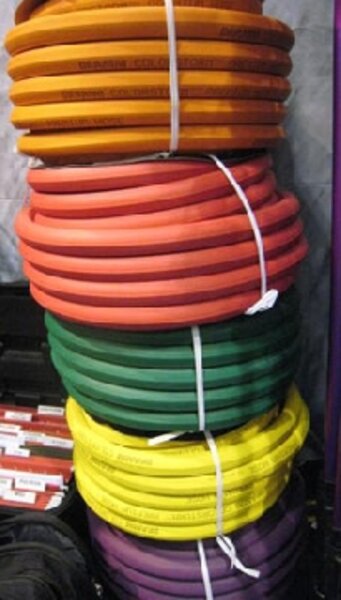Zen and the art of watering the garden by hand
Loading...
I’m finally old enough to water by hand. That is to say, a certain length of living has given me the patience to stand and deliver the optimum amount of water to my plants. And age has granted me the perseverance to get up each morning and do it again — and again. It takes me about an hour. Hand watering is my meditation.
Statistics show that hand irrigation can be more efficient than sprinklers or even drip. Each day I work my way across the deck from container to container — my new dwarf papryus (Papyrus 'King Tut') sucks up every bit of water I give it — I ruminate on what I’ve learned hauling this hundred-foot hose around my house.
Dress your hose in a wand
The average garden hose delivers approximately eight gallons per minute. That’s too much water. I use a watering wand to reduce the flow to more manageable levels, yet get the job done easily, so you can stop the water between containers without having to kink the hose (more on kinks below).
In my experience, all wands eventually leak at the connection, but a piece of white silicone plumbers’ tape wrapped around the hose fitting stops stray drips on my feet — or down my arm when I’m watering overhead.
Splitting up is easy
I had never understood the importance of connectors or splitters until I witnessed a near fistfight during the display gardens set-up at the Northwest Flower and Garden Show. Two neighboring designers needed to water at the same time. Both had hoses, but only one faucet between them.
A nearby worker lamented the lack of a splitter — a neat item that gives you two (or more) connectors. Difficult to find that day in downtown Seattle, but most hardware stores and specialty catalogs carry them.
By using a y-connector, I reserve a designated hose for hand watering, with its plumber’s-taped, non-leaking wand.
When is enough enough?
Halfway through my watering ramble, I’m standing over a newly planted contorted filbert (Corylus avellana ‘Contorta’), called Harry Lauder’s Walking Stick. A hybrid of our native filbert, it should be fairly drought tolerant. But this first season, I water as if it’s still in a container because of the cautionary mantra I’m always repeating in my articles on xeric plants — “must be watered regularly until established.”
The real trick with plants in the ground is that word “regularly.” I try never to let the soil under the mulch go completely dry. Somewhat moist soil attracts water. Dry dirt repels it, so repeated gentle soakings are the only way to make sure the whole root ball and its surrounding ground get wet again.
Depending on your soil type, the rough guide is one inch of water percolates down one foot. Water tends to spread underground in a pyramidal shape, wider at the bottom. Very little actually moves sideways. Testing garden soil is the best way to see how your watering efforts are working. Until you know for certain, keep digging small tester holes near plants.
It’s a shock if you discover all that water you just delivered penetrated only a few inches — but it’s easily remedied with persistence. In too-dry containers, the soil pulls away from the pot sides, so when you water, it bypasses the rootball and pours out the bottom. Soak the whole thing in a bucket to rehydrate. Or keep coming back to give it another shot until water is clearly sinking in to the soil surface.
Getting the kinks out
I drag my hose the length of the house to the hanging baskets of white Non-stop begonias under the grape arbor. I lift the wand, press down and — no water. A kink. Sigh. All my hoses kink. Even those that promise not to.
My walking meditation involves pacing back along the hundred feet of hose to discover the blockage. That’s my rationalization, but hose kinking is the downside of hand watering. I have no solution, although the Dramm salesman at the Farwest Show claimed that their multisided hose construction unkinks itself. He demonstrated. I saw the kink flip over and out, but I haven’t yet tried that brand.
Is there a watering dance that would allow my hose never to kink? I can straighten it out, untwisting it like a giant phone cord, but the hose obeys a stronger imperative; its memory code returns it to a loop — pulled straight, it kinks.Any ideas on this conundrum would be appreciated.
In the meantime, my meditation ends when I wrestle this coiled leviathan into a semblance of order, and leave it until tomorrow, cleverly disguised in the corner as a garden hose.
Mary-Kate Mackey, co-author of Sunset’s Secret Gardens — 153 Design Tips from the Pros and contributor to the Sunset Western Garden Book, writes a monthly column for the Hartley Greenhouse webpage and numerous articles for Fine Gardening, Sunset, and other magazines. She teaches at the University of Oregon’s School of Journalism & Communication. She will be writing about water in the garden for Diggin' It. See her previous Monitor blog post here.
Editor’s note: For more on gardening, see the Monitor’s main gardening page, which offers articles on many gardening topics. Also, our blog archive and our RSS feed. You may want to visit Gardening With the Monitor on Flickr. Take part in the discussions and get answers to your gardening questions. If you join the group (it’s free), you can upload your garden photos and enter our next contest. We’ll be looking for photographs of fruits. So find your best shots of summer’s blueberries, peaches, plums, etc., and get out your camera to take some stunning shots of early fall apples. Post them before Sept. 30, 2009, and you could be the next winner.





